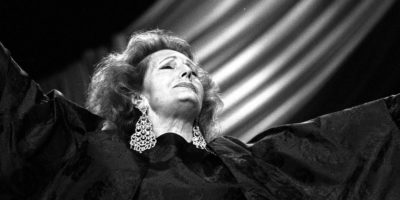
Ana Mendieta in Havana in 1981-by GM-Wikimedia Commons
Top 10 Facts About Ana Mendieta
Ana Mendieta was a multidisciplinary artist, whose work floated weightlessly between performance, sculpture, earth art, photography, and film. She is renowned today for a richly completed oeuvre that merged Afro-Cuban religious traditions with feminist ideas and ecological concerns. Mendieta was born on November 18, 1948, in Havana, Cuba. She gave hope to many through her art on identity, assault, death, place, and belonging matters although her groundbreaking career came to a sudden end when she died at the age of 36. Here are some of the things to know about Ana Mendieta.
Read also; Top 10 Famous Cuban people
1. Mendieta is from a prominent political family

Politics text posted on a globe by Tara Winstead-Pexels
Mendieta was born in Havana to parents lawyers Ignacio Mendieta, who worked for the FBI during WWII, and Raquel Mendieta, a chemistry teacher. Her father was politically active and initially supported Fidel Castro’s ascension to power. By 1960, however, he had parted with the Cuban Revolution’s commander and was frightened about the safety of his family so he sent his daughters to the United States.
2. She spent the majority of her childhood under foster care in the United States
Mendieta was born in Havana, Cuba, into a renowned political family. Following the Cuban Revolution in 1961, Mendieta’s father was imprisoned for his hostility to Fidel Castro, and the 12-year-old Mendieta with her sister Raquelin, 15 were deported to the United States through Operation Peter Pan. The two girls spent their first weeks in refugee camps before being transferred to various institutions and foster homes across Iowa. “I am overwhelmed by the feeling of being cast from the womb, having been torn from my homeland during my adolescence.” “My art is how I reestablish the bonds that connect me to the Universe,” she once stated.
3. Her artwork emphasized a spiritual and physical connection to the planet

A quote printed on paper by Karolina Grabowska-Pexels
Mendieta believed that by fusing her body with the soil, she could reclaim her wholeness: “Through my earth/body sculptures, I become one with the land… Nature becomes an extension of myself, and I become an extension of nature. This obsessive act of reasserting my earthly ties is essentially the reactivation of primal beliefs… [in] omnipresent feminine energy, the afterimage of being encompassed within the womb, is a representation of my hunger for existence.” She created nearly 200 works of art utilizing the earth as a sculptural medium during her lifetime.
4. Her artwork addressed issues of identity, cultural heritage, and feminism
During her career course, Mendieta worked in various places including works in Cuba, Mexico, Italy, and the United States. Like any other artist, she had a number of themes to which she had a strong persona link. Most of her writing was semi-autobiographical, based on her experience of being uprooted from her native Cuba, and addressed issues such as feminism, violence, life, death, identity, place, and belonging. Among her many works were ephemeral outdoor performances, photography, sculptures, and drawings. Her work is commonly associated with the four Classical elements.
5. She received her BA and MA in painting from the University of Iowa

The University of Iowa Art Campus during the Iowa Flood of 2008-by Craigdietrich-Wikimedia Commons
Mendieta was a French major with an art minor before transferring to the University of Iowa, where she was influenced by the avant-garde community and the hills of the Iowa landscape. She received a BA (enrolled 1969-1972) and MA in painting, as well as an MFA (enrolled 1972-1977) in Intermedia from famous artist Hans Breder. During her time at art school, she suffered a lot of prejudice. Mendieta’s work at college focused on blood and violence against women. Her interest in spiritualism, religion, and archaic rituals began at this time.
Read also; 35 Famous Modern Artists you should All know About
6. Mendieta was a member of the feminist art community
Mendieta was a member of Artists In Residence Inc (A.I.R. Gallery) in New York, which was the first gallery for women in the United States which provided her with the opportunity to network with other female artists at the forefront of the feminist movement of the time. She met female artists such as Nancy Spero (1926-2009), Mary Beth Edelson (1933-2021), Barbara Kruger (b. 1945), and Carolee Schneemann (1939-2019), also, film critic B. Ruby Rich, and Artforum editor Ida Panicelli. Many of these ladies pushed for Mendieta after her untimely and strange death, when her husband Carl Andre was on trial for her murder (though he was acquitted), attending the trial, testifying on her behalf, and ensuring her work was recognized. Advocacy groups are still organizing actions in her honor today.
7. She was also active in film work

Spiral film stream by Pietro Jeng-Pexels
Mendieta made numerous experimental films in the 1970s which include; Creek (1974): This film expands on Shakespeare’s Ophelia persona, Chicken Movie, Chicken Piece (1972), Parachute (1973), Moffitt Building Piece (1973), Grass Breathing (1974), Dog (1974), Mirage (1974), Weather Balloon, Feathered Balloon (1974), Silueta sangrienta (1975), Energy Charge (1975), Ochún (1981), Untitled (1981), Esculturas Rupestres (Rupestrian Sculptures; 1981), and Birth (Gunpowder Works; 1981). Some of her films, including Pain of Cuba/Body I Am (2018) and The Earth That Covers Us Speaks (2018), were released posthumously.
8. Mendieta’s art can be found in numerous significant public collections
Many major public collections house Mendieta’s work, including the Solomon R. Guggenheim Museum, Metropolitan Museum of Art, Whitney Museum of American Art, and Museum of Modern Art in New York, the Art Institute of Chicago, the Centre Pompidou in Paris, the Musée d’Art Moderne et Contemporain in Geneva, the Tate Collection in London, the Nasher Sculpture Center in Dallas, and the Pérez Art Museum Miami.
Read also; 20 Famous Women Artists who were Better Than Men
9. Her death was a mystery

A woman falling from a building by ntnvnc –Pixabay
Ana Mendieta died on September 8, 1985, in New York City, after falling from her 34th-floor apartment at 300 Mercer Street in Greenwich Village. She shared the apartment with her eight-month-old husband, minimalist sculptor Carl Andre. The circumstances of her death have been a source of contention. She plummeted 33 floors to the roof of a deli. Neighbors reported hearing the pair arguing aggressively just before her death. Mendieta screamed “no” right before her death, and Andre had scratches all over his face. In February 1988, Andre was cleared of second-degree murder in a nonjury trial. To honor the 25th anniversary of her death, New York University hosted a symposium titled Where Is Ana Mendieta? in 2010.
10. Her legacy still lives on
The Cintas Foundation honored Mendieta with a Lifetime Achievement Award in 2009. In 2010, she was the subject of the documentary Where Is Ana Mendieta? by Richard Move. His video, BloodWork – The Ana Mendieta Story, was included in the exhibition and symposium 25 Years Later. The New York Times published a delayed obituary for her in 2018, stating, “Mendieta’s art, sometimes violent, often unapologetically feminist, and always raw, left an indelible mark before her life was cut short.”
Mendieta was a trailblazing artist whose feminist thinking influenced her perception of the natural world. Ana Mendieta, a multidisciplinary artist, is renowned today for a richly completed oeuvre that merged Afro-Cuban religious traditions with feminist ideas and ecological concerns.
Planning a trip to Paris ? Get ready !
These are Amazon’s best-selling travel products that you may need for coming to Paris.
Bookstore
- The best travel book : Rick Steves – Paris 2023 – Learn more here
- Fodor’s Paris 2024 – Learn more here
Travel Gear
- Venture Pal Lightweight Backpack – Learn more here
- Samsonite Winfield 2 28″ Luggage – Learn more here
- Swig Savvy’s Stainless Steel Insulated Water Bottle – Learn more here
Check Amazon’s best-seller list for the most popular travel accessories. We sometimes read this list just to find out what new travel products people are buying.









